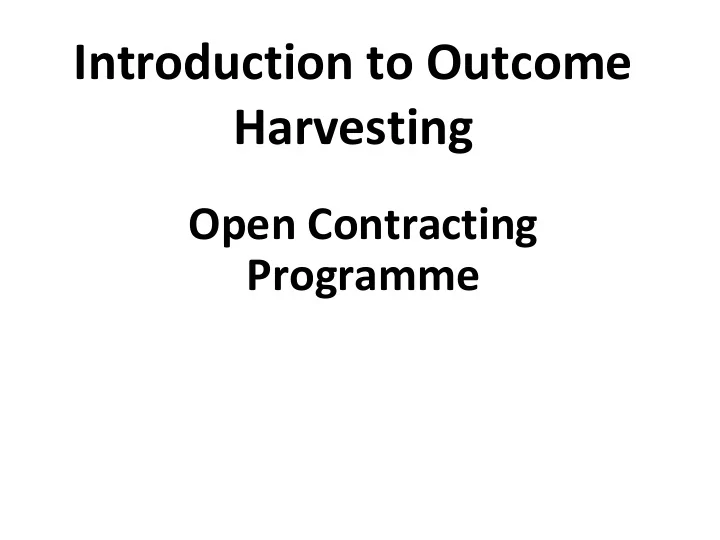

Introduction to Outcome Harvesting Open Contracting Programme
Agenda Definition of Outcome Outcome 1 Introduction to Outcome Harvesting Harvesting Added Value of Outcome Harvesting 2
Part 1 1h Purpose: Present Outcome Harvesting Intended results: To understand Outcome Harvesting as a Monitoring & Evaluation instrument. 3
Introduction to Outcome Harvesting Outcome Harvesting is a method that enables evaluators, grant makers, and managers to identify, formulate, verify, and make sense of outcomes. Using Outcome Harvesting, the evaluator or harvester collects information from reports, personal interviews, and other resources to document how a given program or initiative has contributed to outcomes. Outcomes can be positive or negative, intended or unintended, but the connection between the initiative and the outcomes should be verifiable. 4
How OH fits within the DMEL cycle Theory of Outcome Change Harvesting Learning & Making Sense 5
Results in Outcome Harvesting Inputs Activities Outputs Outcomes Impact 6
Definition of Outcome SOCIETAL In the light of ACTOR Group or Individual community Organisation Institution the Theory of Change Policies Practices Activities Relationships agendas BEHAVIOUR 7
Example Outcome: In 2010, the African Development Bank conducts an extensive global consultation on its “Energy Strategy Approach Paper” in 15 countries, significantly larger than initially proposed. Who is the social actor? What is the demonstrated change? 8
Example Relevance: Originally the African Development Bank planned one consultation in Harare. The extensive consultation allowed CSOs in African countries to share their concerns on the Bank’s energy strategy, and ensure projects are targeted to address energy access for the poor. Is the outcome noteworthy in light of the programme’s Theory of Change? 9
When is it YOUR outcome? When your process influenced the outcome Effec Cause Contribution t 10
Contribution: HSC advocated for a more Example robust consultation process with the Bank’s energy team and HSC submitted to them a list of cities where they should be organizing consultations, leveraging on its extensive partner network. HSC was able to organize and work with local groups in 15 countries across Africa with the objective that the Bank receives a strong and consistent message during the consultations. Is HSC’s influence plausible? Are the outcome and contribution statements verifiable? 11
The Outcome Harvesting process 1. Design the harvest 2. Identify & formulate outcomes 3. Finalise outcomes 4. Substantiate 5. Analyse, interpret 6. Support use of findings Outcome Harvest 12
Why focus on outcomes? Observable Societal Influenced by and relevant Actor your change activities Toda Yesterda Before y y Yesterday 13
Outcomes are a bridge between what you do and the end result you seek... ...along with others Contribution of the programme INPUTS ACTIVITIES IMPAC OUTPUTS T Contribution of different actors and factors 14
In summary, an outcome is: An observable change in agenda, activity, relationships, policy or practice in another actor. That is relevant in the light of the Green & Inclusive Energy Programme Theory of Change. And to which the Green & Inclusive Energy Programme has contributed – partially or wholly, directly or indirectly, intentionally or not. 15
The added value of Outcome Harvesting Visualising social change Map of Outcomes Change Strategy 16
O Outcome statements content S R C O utcome description : Who (actor) changed what, when and where? R elevance: The importance of the outcome in the light of the programme’s Theory of Change or the objectives of this programme, project or partner. C ontribution: What activities and outputs contributed to the change described in the outcome. This contribution can be direct or indirect, small or large, intended or unintended. S ources: The specific documents and people who provided the data. 17
Questions & answers Do you have any questions about the potential of Outcome Harvesting as a Monitoring & Evaluation instrument? 18
For more information about Outcome Harvesting, join the emerging community of practice at www.outcomeharvesting.net. For a discussion forum amongst colleagues, a library of resources customised for your use and a calendar of events within the Strategic partnership, go to the Hivos Outcome Harvester Coordinators Blended Learning Platform at https://dgroups.org/groups/outcome-harvesting/ hivosoh/. 19
Recommend
More recommend